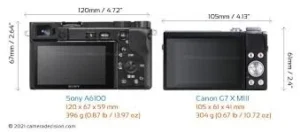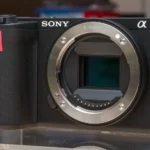When deciding between the Canon PowerShot G7 X Mark III and the Sony A6100, it’s important to understand the differences in their design, features, and performance. Both cameras have garnered significant attention for their impressive specs, but which one is right for you? Let’s dive into a detailed comparison of the Canon PowerShot G7 X Mark III vs Sony A6100, so you can make an informed choice.
Design and Build: Which Feels More Comfortable?
Both the Canon PowerShot G7 X Mark III and Sony A6100 are compact and portable, making them great options for casual photographers or vloggers who need a camera that’s easy to carry around. But, there are some key differences in their design that may sway your decision.

Canon PowerShot G7 X Mark III:
- Size and Weight: The G7 X Mark III is extremely compact, fitting comfortably in your pocket or a small bag. It weighs around 304 grams (10.7 ounces).
- Fixed Lens: Unlike the Sony A6100, the G7 X Mark III has a fixed lens with a 24-100mm f/1.8-2.8 aperture. This makes it ideal for travel and casual shooting, without the need to carry extra lenses.
- Screen: One of the standout features of the G7 X Mark III is its tilting touchscreen, which can flip up 180 degrees for selfies and vlogging.
Sony A6100:
- Size and Weight: The A6100 is a bit larger and heavier, weighing in at 396 grams (14 ounces). However, it’s still relatively compact compared to many DSLR cameras.
- Interchangeable Lenses: The A6100 offers more flexibility thanks to its Sony E-mount system, allowing you to choose from a wide variety of lenses.
- Screen: The A6100 features a tilt-up screen as well, but it only flips 90 degrees, making it less ideal for vlogging compared to the G7 X Mark III.
Image Quality: Which Produces Sharper Photos?
Both cameras feature high-quality sensors, but their capabilities differ in important ways.
Canon PowerShot G7 X Mark III:
- Sensor: The G7 X Mark III uses a 1-inch type sensor, which is quite large for a compact camera. This allows for better low-light performance and more detailed images.
- Resolution: It offers a 20.1 MP resolution, which is more than enough for most everyday photography and even professional use.
- Image Processing: Canon’s DIGIC 8 image processor helps to enhance the quality of photos, producing sharp and vibrant colors.
Sony A6100:
- Sensor: The A6100 comes with a 24.2 MP APS-C sensor, which is larger than the 1-inch sensor on the G7 X Mark III. The larger sensor allows for even better image quality, especially in terms of depth of field and dynamic range.
- Resolution: With 24.2 MP, the A6100 delivers higher resolution, which can be beneficial if you plan to crop your photos or print them in larger sizes.
- Image Processing: The A6100 uses Sony’s BIONZ X processor, which helps in delivering clean images with less noise, particularly at higher ISO settings.

Video Capabilities: Which One Wins for Vloggers?
Video quality is another area where these two cameras differ. Vlogging and content creation are key reasons people choose either of these cameras, so let’s compare their video features.
Canon PowerShot G7 X Mark III:
- Video Resolution: The G7 X Mark III supports 4K video recording at 30fps, as well as 1080p at 60fps.
- Autofocus: The camera offers Dual Pixel CMOS autofocus, which is smooth and reliable for video, especially when transitioning between subjects.
- Microphone Input: Another huge advantage for vloggers is the microphone input, which allows you to use an external microphone for better sound quality.
Sony A6100:
- Video Resolution: Like the G7 X Mark III, the A6100 can shoot 4K video at 30fps, along with 1080p at 120fps for smooth slow-motion footage.
- Autofocus: The A6100 features Real-Time Eye Autofocus and Real-Time Tracking, which makes it superior in keeping subjects sharp, even when they’re in motion.
- Microphone Input: The A6100 also supports an external microphone, giving vloggers the ability to capture high-quality audio.
Battery Life: Which Lasts Longer?

Battery life is often a critical factor for photographers and videographers who spend long hours shooting. Here’s how these two cameras stack up:
Canon PowerShot G7 X Mark III:
- The G7 X Mark III offers a battery life of approximately 235 shots per charge (CIPA standard). While not the longest battery life, it’s reasonable for a compact camera, especially when you’re using it for casual shooting or short vlogs.
Sony A6100:
- The A6100 offers a battery life of approximately 420 shots per charge, thanks to its larger battery. If you’re shooting for extended periods, such as on trips or long vlogging sessions, the A6100 will generally last longer.
Price and Value: Which Offers More Bang for Your Buck?
The Canon PowerShot G7 X Mark III is generally priced lower than the Sony A6100, making it a more budget-friendly option. However, while the G7 X Mark III may be cheaper, the A6100 offers additional features, such as a larger APS-C sensor, better autofocus, and interchangeable lens support. If you’re looking for a camera that can grow with your photography or videography skills, the A6100 may offer better long-term value.
Conclusion: Which Camera Should You Choose?
Both the Canon PowerShot G7 X Mark III vs Sony A6100 offer impressive features, but the right choice depends on your needs.
- Choose the G7 X Mark III if you want a compact, easy-to-use camera with a fixed lens, making it ideal for travel, vlogging, or casual photography. The microphone input and 4K video make it perfect for content creators who need a pocketable camera without sacrificing video quality.
- Choose the Sony A6100 if you’re looking for a more versatile system with a larger APS-C sensor, better autofocus, and interchangeable lenses. It’s a great choice for users who want a camera that can be used for a wider range of photography and videography situations.
At the end of the day, it all comes down to your priorities. Do you want something ultra-portable with a fixed lens, or are you after a more advanced system with room to grow?
So, Canon PowerShot G7 X Mark III vs Sony A6100—which one fits your style?










